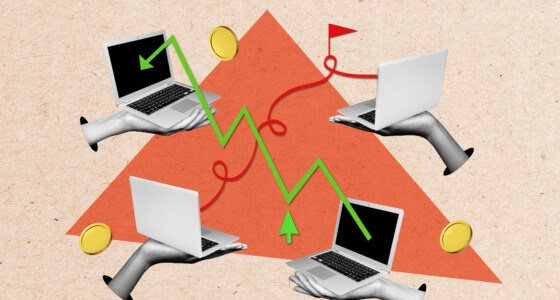

You can have a level of reliance on divergences to provide significant trading signals when you use them with other trading strategies and tools. Understanding divergence helps you to have a more balanced analysis of charts and trends.
Some traders worry about how indicators and price action tend to lag with divergences, but you can take advantage of this feature to determine good entry points for trades. Both trend-following and reversal traders can define their exit time using divergences.
Divergences are a core part of a strong trading strategy alongside other relevant signals. Using trade with divergences independently isn’t ideal, but you can experiment with it for a start.
What Does Divergence Mean?
The first step to using divergences is understanding what it means, including the information it gives on price. It can be a confusing concept for some beginner traders, so it’s ideal to gain some clarity on the subject.
A divergence shows up on charts when the prices reach a newer high while the indicator you’re working with is at a lesser high. This means that the price action and indicator aren’t in sync, and you’re to closely monitor your charts even when you can’t easily detect what’s happening by a simple look.
In simpler terms, a divergence occurs when the price action isn’t in unison with your indicator. This is the most fundamental way of defining divergence, but we’ll explore the more complex areas and how you can trade with them.
RSI Divergence
Divergences are compatible with all indicators, including the Relative Strength Index or RSI, which is perhaps the most interesting. The RSI strikes a comparison between an average gain and loss for a specific timeframe.
If you have an RSI set to 16, for instance, it’ll compare the bearish and bullish candles over the previous 16 candles. Getting a high RSI shows that the bullish candles were stronger and more in the past 16 candles. On the other hand, a lower RSI value means the bearish candles were stronger than the bullish ones among the previous 16 candles.
When Do You Notice an RSI Divergence?
The key to accurately analyzing divergences is knowing when an indicator is low or high. This analysis requires traders to explore what the charts’ lines mean deeply.
With an RSI, you can compare single trend waves to gauge how strong the trend is. Let’s explore three cases to get a complete understanding of the concept:
- If the RSI experiences such highs when there’s an uptrend, it means there’s no difference in the trends’ movement. The RSI reaching an equivalent high doesn’t mean a divergence because the uptrend shows stability and strength. The RSI experiencing a greater high doesn’t mean a reversal; it simply tells you that there’s a stable momentum for the trend.
- The RSI typically reaches a newer high when there’s a strong and solid bullish trend. This shows that the bullish candles in the current wave were much larger and stronger compared to the prior wave.
- When you observe that a price reaches a greater high while the RSI gets to a lesser high in a bullish trend, it shows that the past price action was stronger than the current bullish candles. This will cause the trend to lose momentum and qualify as a divergence.
Note! A divergence doesn’t always guarantee a complete reversal or trend shift; rather, it indicates when a price point loses some momentum and moves sideways.
The Mistake of Regular Technical Analysis
Common technical analysis assumes that there’s a trend when the price point gets to a greater right, but that’s hardly the case. If you place your confidence in the lows and highs when interpreting your prices, you may ignore other relevant details that will give you a more comprehensive view of the market. A trend may look strong or healthy with a single look, but a deep observation may reveal that the candles are losing momentum.
The ability to identify a divergence on your indicator tells you when the trends are changing and possibly reaching an end in the nearest future.

How To Trade a Divergence?
No traders want to enter trades with no meaningful end. To prevent such trade entries, it’s ideal to include other tools in your strategy kit box. While divergence is a relevant detail to analyze when making decisions, it isn’t a strong tool alone, and it may produce undesirable results when used continuously by itself. To make a stronger strategy, you’ll need to consider other factors.
In the chart above, you can see that the price made two divergences but never sold off. Thus, the divergences only underline short-term consolidation.
Location
Whatever trading system you use, the general concept of location applies. When you include the location filter, it improves the strength of your trades and signals. Rather than making trades because of a single divergence signal, you can observe the price point until it moves to a past support zone and then find divergences and changes in trends to compare with entry times.
We can make such a deduction using the chart above. The left side shows two divergences with an uptrend. The first divergence was a complete failure, and the second led to a successful trade.
Looking at the higher time in the right frame, we can tell the first divergence takes place randomly, and the other is at a significant resistance level (the yellow arrow and line). Being a smart trader involves knowing your resistance or support zones and watching the price change in your favor. Working with such a strategy will lead to better results.
The Bottom Line
Divergences are significant markers you can use as a trader to understand price changes. The ability to detect the right signals and use divergences as a tool alongside other trading tools will enhance your trading arsenal and cause you to take a much more in-depth approach when monitoring prices.








